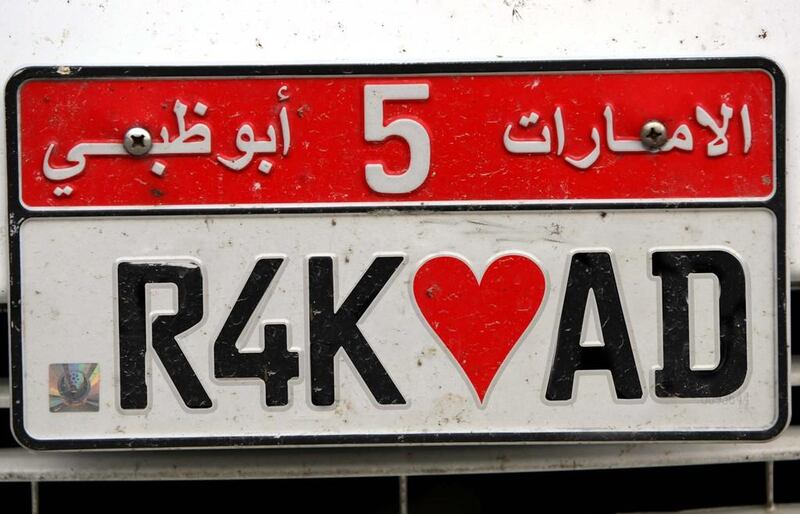At the Suan camel track on Friday mornings, one car stands out. When Ali Al Khatri bashes the dunes, people know he’s coming. Among dozens of white 4x4s, the distinctive red of Al Khatri’s Nissan Patrol affords him a certain renown during races, whether or not his camels perform well.
It is no ordinary red. It is the same shade as the small square with the serial number of his Abu Dhabi plates, known to some as “Abu Dhabi red”. For Al Khatri, it is about coordination. He wants his car to match his plates. Two weeks after driving it off the lot, he returned and paid Dh19,000 to repaint and reupholster it in the right hue. His 40 camels wear matching blankets. The colour has become his signature.
“I like this colour, I don’t know why,” says Al Khatri, 40, the manager of the Suan Camel Race Association. “I need my car to be red. When I see anything red, I need it.”
To Al Khatri, it’s the red that matters and the emirate it represents is incidental.
However, the distinctive red square is a symbol of the Abu Dhabi licence plates much valued by collectors. When assessing plates, it is not just the identification number that matters. Plate traders take the issuing emirate and serial number or letter into account.
Plates issued in Abu Dhabi and Dubai are at the top of the hierarchy. Residents in the Northern Emirates go to great lengths for this status symbol. As with any luxury good, expense is equated to rarity and desirability. Abu Dhabi plates are the priciest.
“I never got a Ras Al Khaimah plate in my life,” says Ibrahim Al Ali, 25, an Emirati from the emirate. “Only Abu Dhabi.”
Friends agree. “Capital plates are so expensive, not like in Ras Al Khaimah,” says Mohammed Al Nuaimi, 25, who owns a Dubai 808 N plate. “Really, Abu Dhabi is the best. Abu Dhabi is something exceptional. VIP.”
More important than price is symbolism. Abu Dhabi is synonymous with money, power, nationalism, unity and a welfare government that offers citizens housing grants, roads, hospitals and employment with the police, army and high-salary ministries.
“I just bought an Abu Dhabi plate because it’s the capital city of the country,” says Muaath al Nuaimi, 21, an administrator at Al Shaheen Adventure. “All the resources, everything we get comes from Abu Dhabi.”
However, Dubai’s successful bid for Expo 2020 has increased its plate popularity. “Many people want to support Dubai Expo but that doesn’t mean that they like Dubai more or that it’s more expensive,” says Al Nuaimi.
His friends identify with Dubai’s glamour. In Ras Al Khaimah, empty seaside car parks are popular night spots for young men to sit, chat and show off cars carrying city plates, with all the wealth and prestige this implies. The world record stands at Dh52.2million for the number “1” plate at an auction that was held at Emirates Palace.
On a recent Friday night, a pair of brothers parked beside Al Nuaimi, displaying matching 66499 Dubai plates in the M and N series. When men glanced at the electric blue Nissan patrol and metallic pink Range Rover, it was the Dh10,000 plates that got noticed. It may seem pricey, but Gulf cruising culture is a way to express identity with car customisation.
During his PhD fieldwork on Emirati identity in RAK, Martin Ledstrup found many men often compared cars in the Emirates, in much the same way as people compare styles and fashion in the West.
“Emiratis style their cars out of personal taste but at the same time they’re so aware of the different social meanings that come with number plates when they’re issued in Abu Dhabi, Dubai or Ras Al Khaimah,” says Ledstrup, who is a student at the University of Southern Denmark and has made car culture a main focus of his studies.
“That, I think, is how fashion works. You express yourself with it, you show who you think you are, while at the same time you go with the vogue, with what is fashionable.”
As for fashion, Al Khatri wears the ubiquitous white kandura of Emiratis but knows a thing or two about accessorising, be it with Abu Dhabi red cars or a watch with its face encrusted with diamonds shaped into a falcon head. “Look at men in the Emirates,” says Al Khatri. “All white colour, white colour, white colour.”
All three of his cars are red. The Nissan Patrol and the GMC, known colloquially as a Jims, are both Abu Dhabi red. Different cars fit different occasions, just as one might wear jeans to a friend’s house and a suit to the office.
“When I go to the city, I like to take my Range Rover,” says the soft-spoken man from the RAK desert town Hamraniya. “When I race my camels, I like to take my Nissan and when I go to the desert I like to take my Jims.”
“The Range Rover is so much money, it’s a good car for the city. When you see camel racing, it’s all Nissans, so many Nissan Patrols. The Jims is a pickup so the tent, the wood, everything fits. You can go in the desert for three days.”
To Al Khatri, all plates are created equal.
“All of this is my country, it’s all United Arab Emirates,” he says. “I love Abu Dhabi, I love Ras Al Khaimah but I do this for the colour. I want a red car and what plate is red? Only Abu Dhabi.”
Anna Zacharias is a freelance journalist raised in RAK.
[ thereview@thenational.ae ]





